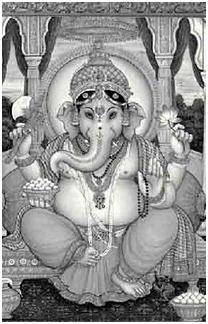Thiruvalanchuzhi Sri Swetha Vinayakar
Sri Vellai Pillaiyar (Swetha Vinayakar or Nuraippillaiyaar) Temple is located in Thiruvalanchuzhi, a village located just 6 kilometers near Kumbakonam, Tamilnadu in India. Swetha Vinayakar, a white colored statue of Ganesha, is the deity of worship in this temple.
Located on route to Swamimalai from Kumbakonam, Lord Ganesha is a feast to watch at Thiruvalanchuzhi.
Lord Ganesha[edit]
Although this is a temple for Lord Shiva, Swetha Vinayakar is the important deity of Thiruvalanchuzhi. Legend has it that the Devas, forgot to worship Lord Ganesha before starting to churn the "Paarkadal" (Ksheera Saagaram). Hence, they were only able to get the Alakala Poison out of it. Indra, king of Devas, later realized that they were only able to get the poison because they had not worshipped Ganesha prior to starting their mission.
Lord Indra created this idol out of the foam (Kadal Nurai) generated from the milky ocean (Ksheera Saagaram) they had churned in their quest for the celestial nectar Amrudham. After they worshipped this idol made of foam (Nurai in Tamil), they were able to obtain the Amrudham from the Ocean. As the deity is made of the foam, there is no Abhishegam etc., performed here.
Naming[edit]
Durvasa Muni is said to have carried out a yagnam here, and the Devas who attended it are said to have established several Siva Lingams in this temple. As the trunk of Lord Ganesha is twisted towards his right hand side, the place is said to have got the name "Thiru Valam Suzhi".
It is also believed that the Kaveri River had once gone back into the earth, and people were worried of the consequences without the existence of this holy river. Heranda Muni, a Rishi, went inside the small passage where River Kaveri disappeared inside Bhumi, goddess of the Earth, and sacrificed himself. After this incident River Kaveri came back to the surface near this shrine and made a complete circle towards the right. Hence, the village got the name Thiruvalanchuzhi.
Art & Sculpture[edit]
There are several interesting sculptural features in this vast temple. Inscriptions reveal that Raja Raja Cholan had made several endowments here. There are also inscriptions from the period of Parantaka Chola I.
There are various quotes in history about the sculptures of this temple. There is a huge window-like structure carved out of a single stone which is facing Lord Ganesha. It is said that we must get Dharshan of Lord Ganesha through this window. Additionally, the ancient sculptors, when they approach the Kings to demonstrate their skills and to get an opportunity to work for the kings, used to tell the king that with the exception of the window of Thiruvalanchuzhi temple, they can do any kind of sculpture, thus proving the magnificence of this structure.



